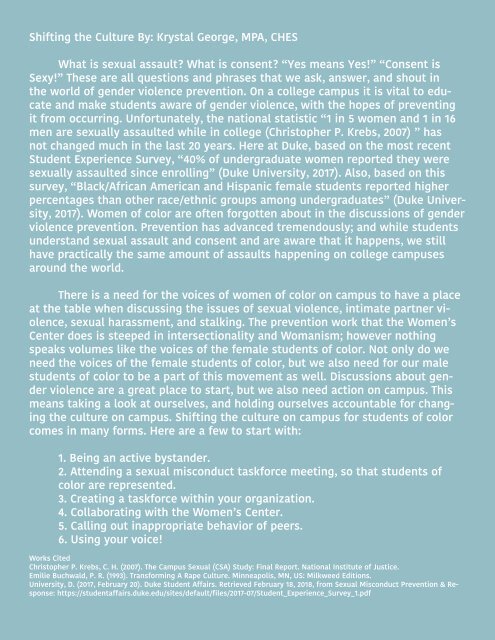LIBERATE
Gender Violence Edition
Gender Violence Edition
Create successful ePaper yourself
Turn your PDF publications into a flip-book with our unique Google optimized e-Paper software.
Shifting the Culture By: Krystal George, MPA, CHES<br />
What is sexual assault? What is consent? “Yes means Yes!” “Consent is<br />
Sexy!” These are all questions and phrases that we ask, answer, and shout in<br />
the world of gender violence prevention. On a college campus it is vital to educate<br />
and make students aware of gender violence, with the hopes of preventing<br />
it from occurring. Unfortunately, the national statistic “1 in 5 women and 1 in 16<br />
men are sexually assaulted while in college (Christopher P. Krebs, 2007) ” has<br />
not changed much in the last 20 years. Here at Duke, based on the most recent<br />
Student Experience Survey, “40% of undergraduate women reported they were<br />
sexually assaulted since enrolling” (Duke University, 2017). Also, based on this<br />
survey, “Black/African American and Hispanic female students reported higher<br />
percentages than other race/ethnic groups among undergraduates” (Duke University,<br />
2017). Women of color are often forgotten about in the discussions of gender<br />
violence prevention. Prevention has advanced tremendously; and while students<br />
understand sexual assault and consent and are aware that it happens, we still<br />
have practically the same amount of assaults happening on college campuses<br />
around the world.<br />
There is a need for the voices of women of color on campus to have a place<br />
at the table when discussing the issues of sexual violence, intimate partner violence,<br />
sexual harassment, and stalking. The prevention work that the Women’s<br />
Center does is steeped in intersectionality and Womanism; however nothing<br />
speaks volumes like the voices of the female students of color. Not only do we<br />
need the voices of the female students of color, but we also need for our male<br />
students of color to be a part of this movement as well. Discussions about gender<br />
violence are a great place to start, but we also need action on campus. This<br />
means taking a look at ourselves, and holding ourselves accountable for changing<br />
the culture on campus. Shifting the culture on campus for students of color<br />
comes in many forms. Here are a few to start with:<br />
1. Being an active bystander.<br />
2. Attending a sexual misconduct taskforce meeting, so that students of<br />
color are represented.<br />
3. Creating a taskforce within your organization.<br />
4. Collaborating with the Women’s Center.<br />
5. Calling out inappropriate behavior of peers.<br />
6. Using your voice!<br />
Works Cited<br />
Christopher P. Krebs, C. H. (2007). The Campus Sexual (CSA) Study: Final Report. National Institute of Justice.<br />
Emilie Buchwald, P. R. (1993). Transforming A Rape Culture. Minneapolis, MN, US: Milkweed Editions.<br />
University, D. (2017, February 20). Duke Student Affairs. Retrieved February 18, 2018, from Sexual Misconduct Prevention & Response:<br />
https://studentaffairs.duke.edu/sites/default/files/2017-07/Student_Experience_Survey_1.pdf





